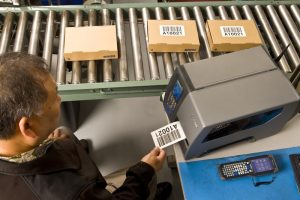Industrial label printers are necessary for high volume barcode and label printing because they are built to withstand rugged conditions and harsh environments such as those found the typical manufacturing facility.
and label printing because they are built to withstand rugged conditions and harsh environments such as those found the typical manufacturing facility.
Most manufacturers are printing a large number of labels for inventory tags or asset management, so they need a robust barcode label printer that can stand up to the volume as well as the environment. If a printer is not designed to withstand dust, debris or rough handling, it will not be able to stand up to the demands of an industrial, high-volume environment. Here are 8 factors to consider when choosing a barcode label printer for use in a manufacturing or warehousing facility.
- Quick Deployment
Time is the one resource you can never regain once it’s gone, so manufacturers need quick deployment and easy configuration to minimize downtime when setting up a new industrial label printer. Quick deployment usually means user-friendly, so you can be assured that training time is minimal and integration is fast and easy.
- Reliable
The high-volume duty cycle in most industrial applications means that reliability must be a prime consideration. Downtime can be costly, and to have to hold up production while the printer is being repaired can mean the difference between happy customers and lost business. Look for proven reliability when doing your research.
- Rugged
Most industrial environments are dirty, dusty, hot, wet or all of the above. To survive, an industrial barcode label printer should be designed to function well in adverse conditions. It must be built for high-volume use, with a rugged design to handle plenty of throughput and multiple users.
- Fast
Most industrial applications equal heavy volume—hundreds or thousands of labels and tags must be printed every day, without interruptions or failures. The right industrial label printer should be capable of printing at a speed of 12 dps to meet the demand; with print quality to match.
- Connected
No two industrial deployments are the same, and most environments undergo constant upgrades and changes. Select a printer with multiple connectivity options, including USB, Wi-Fi, Ethernet, universal standards and more. Also look for remote management capabilities and multi-lingual management options since most manufacturing operations are melting pots of languages.
- Flexible
Space is always at a premium in manufacturing, warehousing and other industrial environments, so many industrial printers are available in multiple form factors so you can find one that meets your needs. You also want a printer that can handle multiple label sizes and materials so you don’t have to deploy multiple printers to handle large and small labels, or paper and foil labels for example.
- RFID Capable
While barcode labels are the most common for data collection today, RFID is gaining ground in many manufacturing and warehouse environments for further increased productivity and greater accuracy. With technology evolving as fast as it does, consider an industrial label printer that is RFID capable. The ideal choice might be one that is capable of simultaneously encoding and printing frequency-agile RFID tags.
- Easy to Use
Touch screens, color screens, screens visible in low light conditions or under bright lights and a multi-language interface should all be on your must-have list. And be sure to partner with a provider who can walk you through the various options available and help you determine which attributes and options are best suited to your unique requirements.
For more information on the world of industrial printers and help to determine if your existing solution is making the grade, contact us today to schedule a warehouse walk-through.

Recent Comments